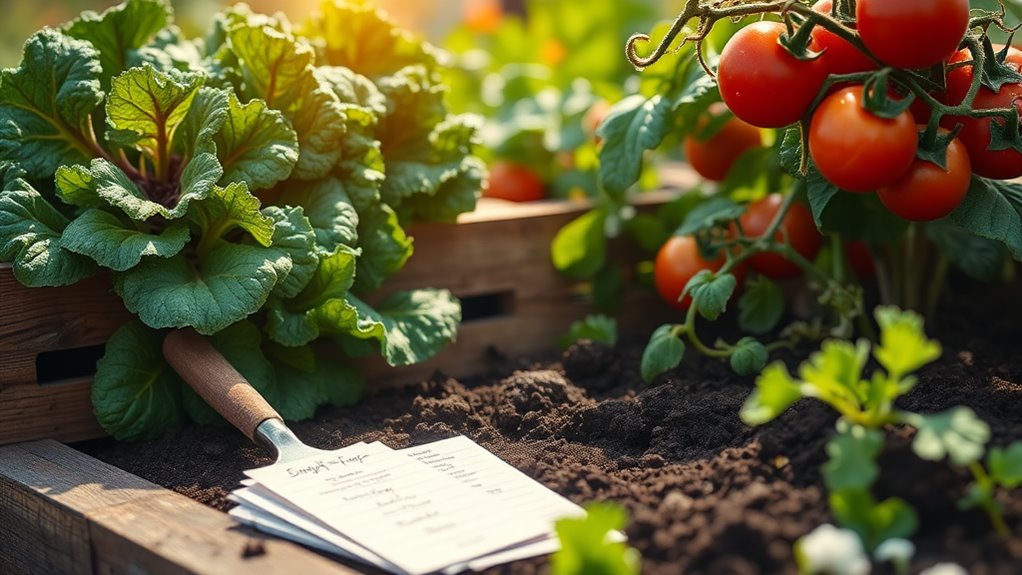I Grew My First Veggies With These Easy Beginner Tricks
Starting your first vegetable garden can be both rewarding and educational. To ensure success, it’s crucial to select fast-growing, low-maintenance varieties like lettuce and radishes. Proper soil preparation, including pH testing and compost addition, sets a strong foundation. Remember, the right watering techniques and adequate sunlight are vital for growth. Additionally, implementing natural pest management strategies will keep your plants thriving. What comes next after planting? Let’s explore the key steps to ensure a plentiful harvest.
Choosing the Right Vegetables for Beginners
When you’re starting your vegetable garden, choosing the right crops can make all the difference in your success.
Opt for fast-growing varieties like lettuce, radishes, and green beans to ensure an easy garden start. These yield quickly and require minimal care.
Additionally, consider your climate zone and soil type, selecting crops suited to these conditions for optimal growth and productivity. Easiest vegetables for beginners will help you identify the most suitable options for your gardening experience.
Essential Tools for Your First Garden
A well-equipped gardener has a significant advantage, especially when starting out.
For your first garden, consider investing in these essential tools:
-
Trowel: Perfect for digging, planting, and transferring soil with precision.
-
Pruning Shears: Necessary for trimming plants and harvesting veggies effortlessly.
-
Gardening Gloves: Protect your hands while providing grip and dexterity.
These tools will ensure your gardening experience is efficient and enjoyable. Additionally, having the right tools can improve your overall gardening success and make the process much more enjoyable.
Preparing Your Soil for Planting
Equipping yourself with the right tools sets a solid foundation for your gardening journey, but without properly prepared soil, your efforts may not yield the desired results.
Start by testing your soil’s pH and nutrient levels. Amend with organic matter like compost or well-rotted manure to enhance drainage and fertility. Additionally, soil testing techniques can help identify specific deficiencies and enable targeted amendments.
Finally, till the soil to a depth of at least 12 inches for optimal growth.
Watering and Sunlight Needs
To ensure your vegetable plants thrive, understanding their specific watering and sunlight requirements is crucial.
Key factors include:
-
Soil Moisture: Water deeply but infrequently to promote root growth.
-
Sunlight Exposure: Aim for 6-8 hours of direct sunlight daily for optimal growth.
-
Time of Day: Water early mornings or late afternoons to reduce evaporation and fungal diseases. Additionally, consider soil moisture levels to tailor your watering schedule effectively.
Monitor plants closely and adjust according to their needs.
Pest Management With Natural Remedies
While nurturing your vegetable garden with the right watering and sunlight, you’ll inevitably encounter pests that threaten your crops.
To manage them naturally, consider neem oil for its effectiveness against insects. Dilute it with water at a ratio of 1:10 and spray on affected areas.
Also, introduce beneficial insects like ladybugs that prey on aphids, effectively reducing pest populations. Additionally, implementing preventive strategies such as crop rotation and companion planting can help maintain a healthy garden ecosystem.
Harvesting and Enjoying Your Homegrown Veggies
Once your vegetables are ready for harvest, knowing the right techniques can significantly enhance their quality and flavor.
Follow these practices to maximize your yield:
- Use sharp, clean tools to prevent damage and disease.
- Harvest early in the morning for optimal moisture retention.
- Store vegetables in a cool, dark place to maintain freshness.
- Employing essential gardening tools can help you efficiently manage your harvest and increase overall productivity.
Enjoy the fruits of your labor while they’re at their peak!

